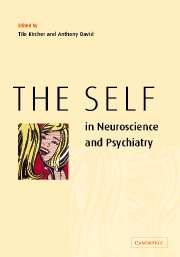Book contents
- Frontmatter
- Contents
- List of contributors
- Introduction: the self and neuroscience
- Part I Conceptual background
- 1 The self and psychiatry: a conceptual history
- 2 The self in philosophy, neuroscience and psychiatry: an epistemic approach
- 3 Phenomenology of self
- 4 Language and self-consciousness: modes of self-presentation in language structure
- Part II Cognitive and neurosciences
- References
1 - The self and psychiatry: a conceptual history
from Part I - Conceptual background
Published online by Cambridge University Press: 18 December 2009
- Frontmatter
- Contents
- List of contributors
- Introduction: the self and neuroscience
- Part I Conceptual background
- 1 The self and psychiatry: a conceptual history
- 2 The self in philosophy, neuroscience and psychiatry: an epistemic approach
- 3 Phenomenology of self
- 4 Language and self-consciousness: modes of self-presentation in language structure
- Part II Cognitive and neurosciences
- References
Summary
Abstract
The concept of self is a construct. It is not a ‘natural kind’ sited somewhere in the human brain. The western concept of self emphasizes individualism and autonomy but this view is cultural and no more scientific or truthful or advanced than the syncytial or collective view of self developed in other cultures and which revolves around family or clan rather than individual. Originally meant by St Augustine to be just a metaphorical or virtual space within which theological models of responsibility, guilt and sin could be played out, the self regained importance in the hands of Luther who started its reification as a private cave where god and man would regularly meet to sort out their differences. During the seventeenth century, the metaphors of the Reformation become secularized and built into liberalism and capitalism. The self survived by becoming a conceptual prop for bourgeois notions such as individual ownership, natural rights and democracy.
Wanting to reinforce the political status quo, nineteenth-century science transformed the political self into a psychological entity and proceeded to ‘naturalize it’ (i.e. render it into a natural kind). This additional reification engendered curious inferences. One was the belief that a ‘self’ really existed inside the European mind and brain. This self was characterized as driving, organized, executive and with a capacity for leadership and domination.
- Type
- Chapter
- Information
- The Self in Neuroscience and Psychiatry , pp. 9 - 39Publisher: Cambridge University PressPrint publication year: 2003
References
- 15
- Cited by



